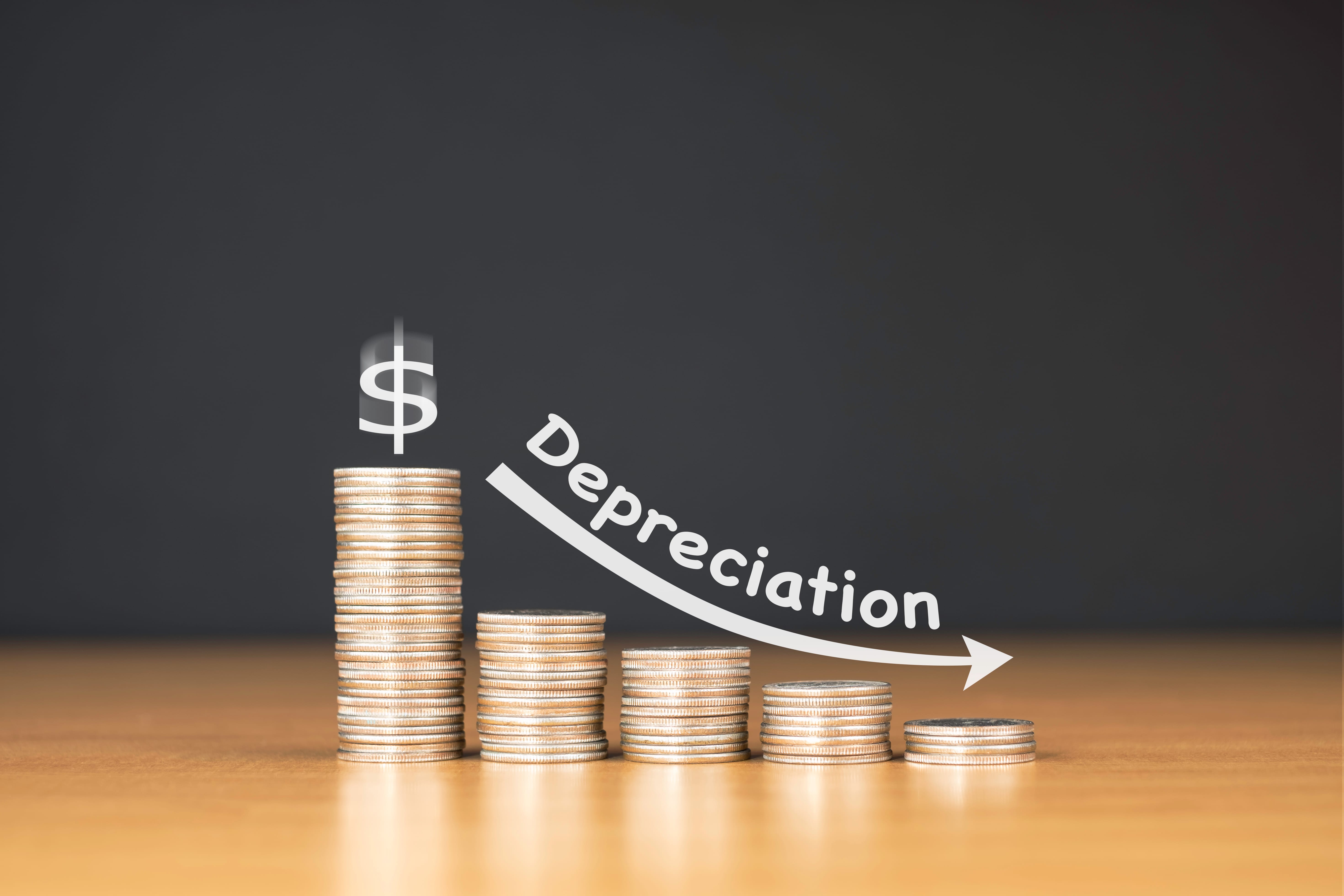What is Depreciation?
Depreciation is a fundamental concept in accounting that refers to the systematic allocation of the cost of a tangible asset over its useful life. It recognises that assets such as property, plant, and equipment lose value over time due to wear and tear, obsolescence, or other factors.
By spreading the cost of these assets over their useful lives, depreciation matches expenses with revenues more accurately, providing a more realistic representation of an organisation’s financial performance.
How Depreciation Works
Depreciation operates on the principle that nearly all material goods lose value over time. It is allocated systematically over an asset’s useful life, reflecting the pattern of its consumption or usefulness to the entity.
This approach ensures that the cost of the asset is spread out evenly over the periods during which it contributes to revenue generation.
Calculating depreciation involves considering several key factors to determine the decrease in the value of an asset over time. These factors include:
- Useful Life: This refers to the period during which the asset remains productive and contributes to the entity’s operations. Once the asset surpasses its useful life, it becomes more economical to replace it rather than continue using it.
- Salvage Value: Also known as residual value, salvage value signifies the worth of the asset after it has completed its useful life. Most assets retain some salvage value, even if it’s only for salvageable parts or materials.
- Cost of Asset: This encompasses the total expenditure associated with acquiring and preparing the asset for use. It includes the purchase price, any applicable taxes, setup and maintenance costs, shipping expenses, and any other related expenditures.
According to AASB 116, the residual value and the useful life of an asset should be reviewed regularly, typically at the end of each financial year. If expectations regarding these values change compared to previous estimates, adjustments should be made to accurately reflect the remaining value and useful life of the asset.
Recognition of Depreciation
Depreciation is recognised irrespective of whether the fair value of the asset exceeds its carrying amount (book value on the balance sheet). Even if an asset’s market value is higher than its recorded value, depreciation is still charged to reflect its consumption over time.
Impact of Repair and Maintenance
Routine repair and maintenance activities do not eliminate the need for depreciation. While these activities may extend the useful life of an asset or improve its efficiency, they do not change the fact that the asset is gradually losing value over time due to factors like wear and tear or obsolescence.
Therefore, depreciation continues to be recognised as long as the asset is in use, regardless of maintenance efforts.
How to Determine Depreciable Amount
As per AASB 116, the depreciable amount of an asset is calculated by subtracting its estimated residual value from its initial cost. The residual value represents the expected salvage or scrap value of the asset at the end of its useful life.
By deducting this value, we ascertain the portion of the asset’s cost that will be depreciated over its useful life.
Significance of Residual Value in Practise
While residual value is an essential component in the calculation of depreciable amount, in many cases, it may be insignificant. In such instances, its impact on the depreciable amount might be negligible, and thus, it might not significantly affect the depreciation expense.
However, it’s crucial for accounting accuracy and adherence to accounting standards to consider residual value in determining the depreciable amount.
Conditions for Zero Depreciation
If the residual value of an asset increases to match or exceed its carrying amount, the asset is considered to have zero depreciable amount.
In other words, if the estimated residual value equals or exceeds the asset’s remaining book value, there is no further depreciation charged until the residual value decreases below the carrying amount again. This scenario might occur if the asset’s expected market value at the end of its useful life increases unexpectedly.
Adjustment of Depreciation Charges
Any changes in the estimated residual value of an asset should be reflected in the depreciation charges. If there is a change in the residual value during the useful life of the asset, it should be accounted for as an adjustment to the depreciation charges.
For instance, if the residual value decreases due to changes in market conditions or technological advancements, the depreciation expense would increase to reflect the reduced value of the asset at the end of its useful life.
Conversely, if the residual value increases, depreciation charges may be adjusted downward to reflect the higher expected value of the asset at the end of its useful life.

Types of Depreciation
Depreciation is a critical aspect of accounting, reflecting the gradual loss of value in assets over time. There are several methods of depreciation, each suited to different scenarios and accounting needs.
Straight Line Depreciation
Straight-line depreciation is the simplest method and is commonly used by small entities with straightforward accounting systems.
- Applicability: Primarily suitable for a small entity.
- Calculation: The cost of the asset, minus its residual value, is divided by its useful life to determine the annual depreciation expense.
Units of Production Depreciation
This method calculates depreciation based on the usage or output of an asset, making it suitable for equipment with quantifiable outputs.
- Applicability: Ideal for assets with measurable outputs, typically high-value equipment.
- Calculation: Depreciation is calculated based on the number of units produced or hours used, determining the depreciation value per unit or hour. This value is then multiplied by the total units or hours used during the year.
Diminishing Value Depreciation
Also known as the sum-of-the-year’s-digits (SYD) method, this approach focuses more on recovering the asset’s cost in the earlier years of its useful life.
- Applicability: Suitable for entities aiming to recover more value upfront.
- Calculation: The remaining useful life of the asset is divided by the sum of the digits representing the asset’s useful life (SYD). This ratio is then multiplied by the asset’s depreciable amount.
Double Declining Depreciation
This method accelerates depreciation, writing off more value in the asset’s early years.
- Applicability: Useful for entities wanting to recover more of the asset’s value at the beginning of its life.
- Calculation: Double the straight-line depreciation rate is applied to the asset’s book value at the start of each year.
Understanding these types of depreciation allows entities to choose the most appropriate method for their assets, ensuring accurate financial reporting and tax deductions. Each method has its advantages and considerations, so it’s essential to select the one that best fits the organisation’s needs and goals.
Start and End of Depreciation
As outlined in AASB 116, depreciation begins when an asset is placed into service for its intended use and ends when it is either classified as held for sale or derecognised from the books.
Commencement of Depreciation
Depreciation commences when an asset is available for use in its intended manner as determined by management. This typically involves the asset being in the appropriate location and condition to perform its function.
For example, machinery is considered available for depreciation when it is installed, operational, and ready to be used in production.
Depreciation continues during idle periods unless the asset is fully depreciated. Even if an asset is temporarily not in use due to maintenance, repairs, or seasonal factors, depreciation is still recognised.
This reflects the ongoing consumption of the asset’s economic benefits over its useful life. However, under usage-based methods of depreciation, such as units of production, the depreciation charge can be zero during periods of inactivity when there is no production.
Termination of Depreciation
Classification as Held for Sale
Depreciation ceases when an asset is classified as held for sale, following the guidelines outlined in accounting standards such as International Financial Reporting Standards (IFRS) or Generally Accepted Accounting Principles (GAAP).
When an asset is classified as held for sale, it is no longer depreciated because it is expected to be sold in the near future, and its carrying amount is adjusted to its fair value less costs to sell.
Derecognition of the Asset
Depreciation also ends when an asset is derecognised from the books, typically due to disposal, retirement, or loss of usefulness.
When an asset is derecognied, its carrying amount is removed from the balance sheet, and any gains or losses on disposal are recognised in the income statement. At this point, depreciation is no longer applicable because the asset is no longer owned or used by the entity.
Understanding the start and end points of depreciation is essential for accurately reflecting the usage and value of assets in financial statements. Proper recognition of depreciation ensures that financial reporting provides a faithful representation of an entity’s financial position and performance over time, in accordance with accounting standards and principles.
Treatment of Specific Assets
Land and Buildings
Land and buildings are treated as separate assets, even when acquired together. Land typically has an unlimited useful life and is not subject to depreciation. In contrast, buildings have a limited useful life and are depreciated over their estimated useful life.
The separate treatment ensures that the depreciation expense accurately reflects the consumption of the building’s economic benefits over time, without impacting the value of the land.
Buildings are subject to depreciation because they undergo wear and tear and eventually become obsolete. Depreciation expenses for buildings are recorded over their useful life, reflecting the gradual reduction in their value.
On the other hand, land is not depreciated because it is considered to have an indefinite useful life and does not experience wear and tear or obsolescence in the same way as buildings.
Land with Dismantlement Costs
In some cases, the cost of land may include expenses for site dismantlement, removal, and restoration. In such instances, the portion of the land asset attributable to these costs is depreciated over the period during which the benefits are obtained.
This ensures that the cost associated with preparing the land for its intended use is recognised over time, matching the expense with the periods during which the benefits are realised.
Although land typically has an unlimited useful life, there may be exceptions where the land itself has a limited useful life. In such cases, the land is depreciated in a manner that reflects the benefits derived from it.
Factors such as changes in zoning regulations, environmental considerations, or planned developments in the area may influence the determination of the land’s useful life and the corresponding depreciation schedule.
This article is general information only and does not provide advice to address your personal circumstances. To make an informed decision you should contact an appropriately qualified professional.
